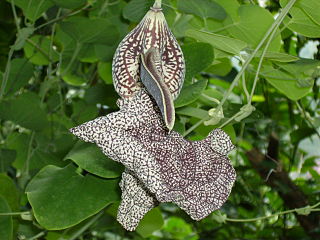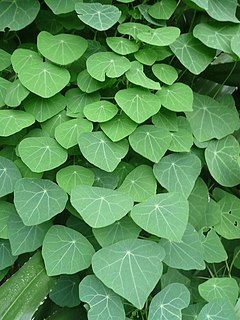
Aristolochia is a large plant genus with over 500 species that is the type genus of the family Aristolochiaceae. Its members are commonly known as birthwort, pipevine or Dutchman's pipe and are widespread and occur in the most diverse climates. Some species, like A. utriformis and A. westlandii, are threatened with extinction.

Stephania is a genus of flowering plants in the family Menispermaceae, native to eastern and southern Asia and Australia. They are herbaceous perennial vines growing to around four metres tall, with a large, woody caudex. The leaves are arranged spirally on the stem, and are peltate, with the leaf petiole attached near the centre of the leaf. The name Stephania comes from the Greek, "a crown". This refers to the anthers being arranged in a crown like manner.

Bhutanitis thaidina, commonly known as the Chinese three-tailed swallowtail, is a rare species of butterfly in the family Papilionidae.
Calophyllum thwaitesii is a species of flowering plant in the Calophyllaceae family. It is found only in Sri Lanka.
Garcinia thwaitesii is a species of flowering plant in the family Clusiaceae. It is found only in Sri Lanka.
Aristolochia cucurbitifolia is a species of plant in the family Aristolochiaceae. It is endemic to Taiwan.
Aristolochia cucurbitoides is a species of plant in the family Aristolochiaceae. It is endemic to China.
Aristolochia delavayi is a species of flowering plant in the family Aristolochiaceae. It is endemic to China.
Aristolochia hainanensis is a species of plant in the family Aristolochiaceae. It is endemic to China.
Aristolochia obliqua is a species of plant in the family Aristolochiaceae. It is endemic to China.
Aristolochia scytophylla is a species of flowering plant in the family Aristolochiaceae. It is endemic to China.
Aristolochia tuberosa is a species of plant in the family Aristolochiaceae. It is endemic to China.
Aristolochia utriformis is a species of plant in the family Aristolochiaceae. It is endemic to China. It is found in forests at about 1900 meters in Yunnan Province. The plants are climbing herbs or shrubs that have pointed leaves with heart shaped bases. The yellow-green flowers are tube shaped and bent. They hang from the base of a leaf.

Aristolochia westlandii is a species of plant in the family Aristolochiaceae. It is found in China and Hong Kong, in valley forests in Guangdong Province at an elevation of 300 to 800 metres. The leaves are long, narrow and pointed. The flowers are bent tubes from 10–15 centimetres (3.9–5.9 in) long that grow from the base of a leaf. They are yellow with purple veins and blotches.
Aristolochia yunnanensis is a species of plant in the family Aristolochiaceae. It is endemic to China.
Euonymus thwaitesii is a species of plant in the family Celastraceae. It is endemic to Sri Lanka.
Palaquium thwaitesii is a species of plant in the family Sapotaceae. It is endemic to Sri Lanka.
Uncaria thwaitesii is a species of plant in the family Rubiaceae. It is endemic to Sri Lanka.
Aristolochia boosii is a species of woody vine in the Aristolochiaceae plant family which is endemic to Trinidad and Tobago. Known only from a few locations in southern Trinidad, the species was first collected by Julius Boos in 1977. After determining that it was new to science, the species was described by Jacqueline Anne Panter in 1981 and named for its discoverer.
Aristolochia stevensii is a plant species native to northwestern Nicaragua and southwestern Honduras. It grows in wet montane forests.




